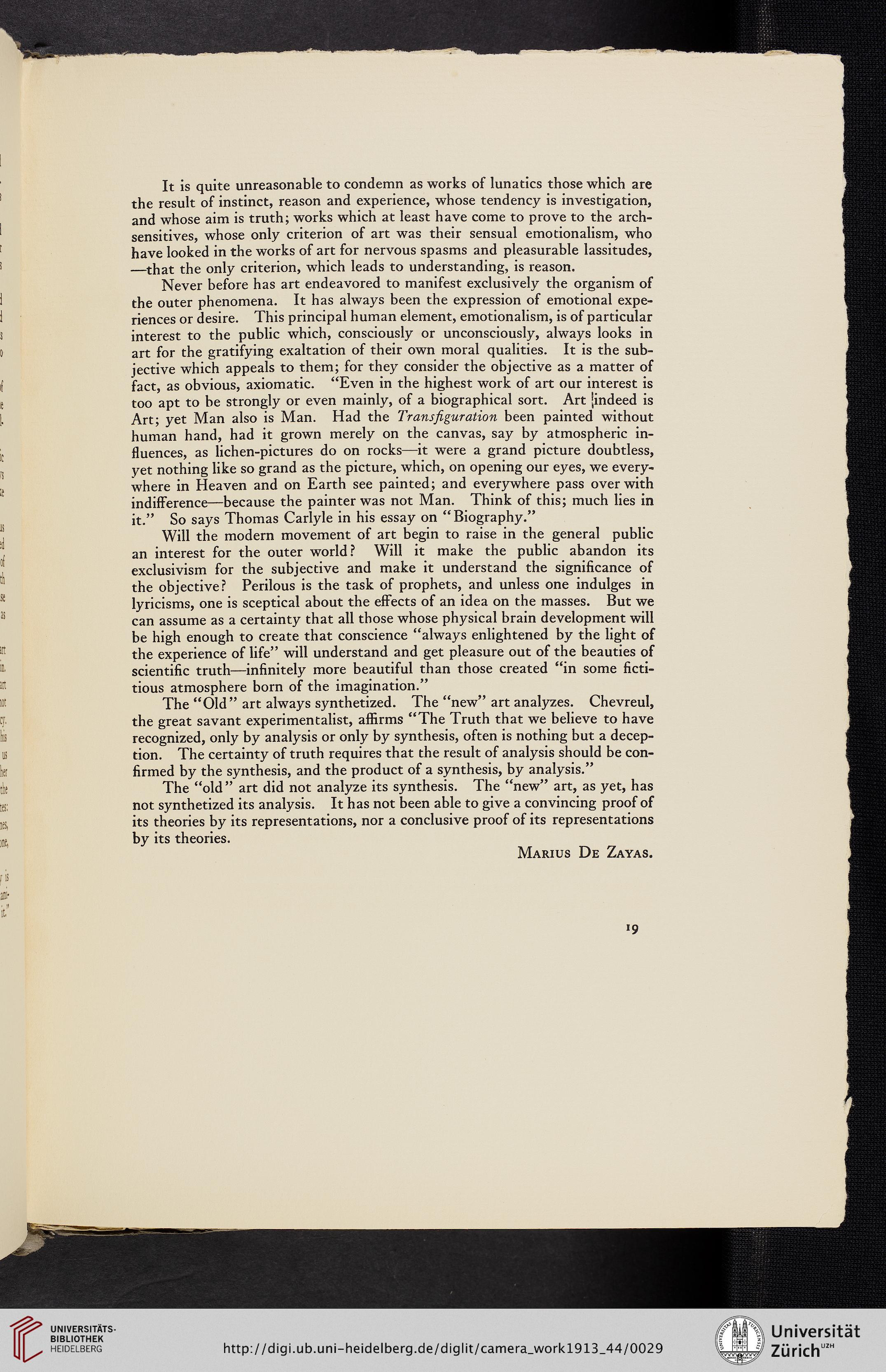Für diese Seite ist auch eine manuell angefertigte Transkription bzw. Edition verfügbar. Bitte wechseln Sie dafür zum Reiter "Transkription" oder "Edition".
It is quite unreasonable to condemn as works of lunatics those which are
the result of instinct, reason and experience, whose tendency is investigation,
and whose aim is truth; works which at least have come to prove to the arch-
sensitives, whose only criterion of art was their sensual emotionalism, who
have looked in the works of art for nervous spasms and pleasurable lassitudes,
—that the only criterion, which leads to understanding, is reason.
Never before has art endeavored to manifest exclusively the organism of
the outer phenomena. It has always been the expression of emotional expe-
riences or desire. This principal human element, emotionalism, is of particular
interest to the public which, consciously or unconsciously, always looks in
art for the gratifying exaltation of their own moral qualities. It is the sub-
jective which appeals to them; for they consider the objective as a matter of
fact, as obvious, axiomatic. “Even in the highest work of art our interest is
too apt to be strongly or even mainly, of a biographical sort. Art jindeed is
Art; yet Man also is Man. Had the Transfiguration been painted without
human hand, had it grown merely on the canvas, say by atmospheric in-
fluences, as lichen-pictures do on rocks—it were a grand picture doubtless,
yet nothing like so grand as the picture, which, on opening our eyes, we every-
where in Heaven and on Earth see painted; and everywhere pass over with
indifference—because the painter was not Man. Think of this; much lies in
it.” So says Thomas Carlyle in his essay on “ Biography.”
Will the modern movement of art begin to raise in the general public
an interest for the outer world? Will it make the public abandon its
exclusivism for the subjective and make it understand the significance of
the objective? Perilous is the task of prophets, and unless one indulges in
lyricisms, one is sceptical about the effects of an idea on the masses. But we
can assume as a certainty that all those whose physical brain development will
be high enough to create that conscience “always enlightened by the light of
the experience of life” will understand and get pleasure out of the beauties of
scientific truth—infinitely more beautiful than those created “in some ficti-
tious atmosphere born of the imagination.”
The “Old” art always synthetized. The “new” art analyzes. Chevreul,
the great savant experimentalist, affirms “The Truth that we believe to have
recognized, only by analysis or only by synthesis, often is nothing but a decep-
tion. The certainty of truth requires that the result of analysis should be con-
firmed by the synthesis, and the product of a synthesis, by analysis.”
The “old” art did not analyze its synthesis. The “new” art, as yet, has
not synthetized its analysis. It has not been able to give a convincing proof of
its theories by its representations, nor a conclusive proof of its representations
by its theories.
Marius De Zayas.
9
the result of instinct, reason and experience, whose tendency is investigation,
and whose aim is truth; works which at least have come to prove to the arch-
sensitives, whose only criterion of art was their sensual emotionalism, who
have looked in the works of art for nervous spasms and pleasurable lassitudes,
—that the only criterion, which leads to understanding, is reason.
Never before has art endeavored to manifest exclusively the organism of
the outer phenomena. It has always been the expression of emotional expe-
riences or desire. This principal human element, emotionalism, is of particular
interest to the public which, consciously or unconsciously, always looks in
art for the gratifying exaltation of their own moral qualities. It is the sub-
jective which appeals to them; for they consider the objective as a matter of
fact, as obvious, axiomatic. “Even in the highest work of art our interest is
too apt to be strongly or even mainly, of a biographical sort. Art jindeed is
Art; yet Man also is Man. Had the Transfiguration been painted without
human hand, had it grown merely on the canvas, say by atmospheric in-
fluences, as lichen-pictures do on rocks—it were a grand picture doubtless,
yet nothing like so grand as the picture, which, on opening our eyes, we every-
where in Heaven and on Earth see painted; and everywhere pass over with
indifference—because the painter was not Man. Think of this; much lies in
it.” So says Thomas Carlyle in his essay on “ Biography.”
Will the modern movement of art begin to raise in the general public
an interest for the outer world? Will it make the public abandon its
exclusivism for the subjective and make it understand the significance of
the objective? Perilous is the task of prophets, and unless one indulges in
lyricisms, one is sceptical about the effects of an idea on the masses. But we
can assume as a certainty that all those whose physical brain development will
be high enough to create that conscience “always enlightened by the light of
the experience of life” will understand and get pleasure out of the beauties of
scientific truth—infinitely more beautiful than those created “in some ficti-
tious atmosphere born of the imagination.”
The “Old” art always synthetized. The “new” art analyzes. Chevreul,
the great savant experimentalist, affirms “The Truth that we believe to have
recognized, only by analysis or only by synthesis, often is nothing but a decep-
tion. The certainty of truth requires that the result of analysis should be con-
firmed by the synthesis, and the product of a synthesis, by analysis.”
The “old” art did not analyze its synthesis. The “new” art, as yet, has
not synthetized its analysis. It has not been able to give a convincing proof of
its theories by its representations, nor a conclusive proof of its representations
by its theories.
Marius De Zayas.
9



